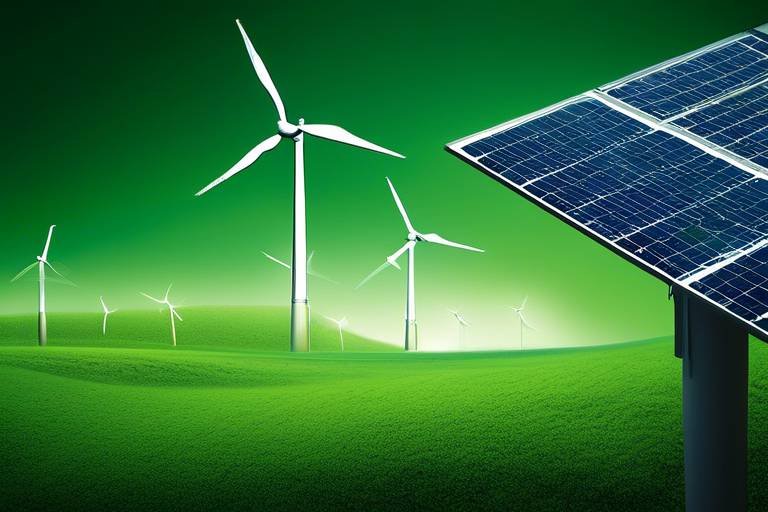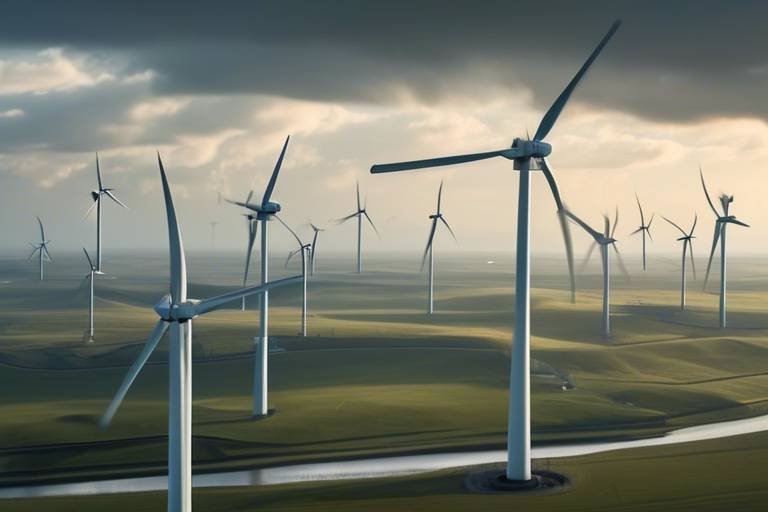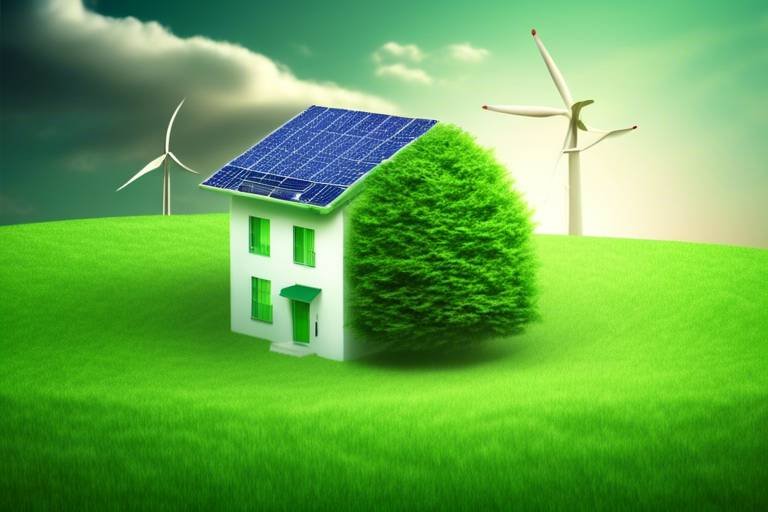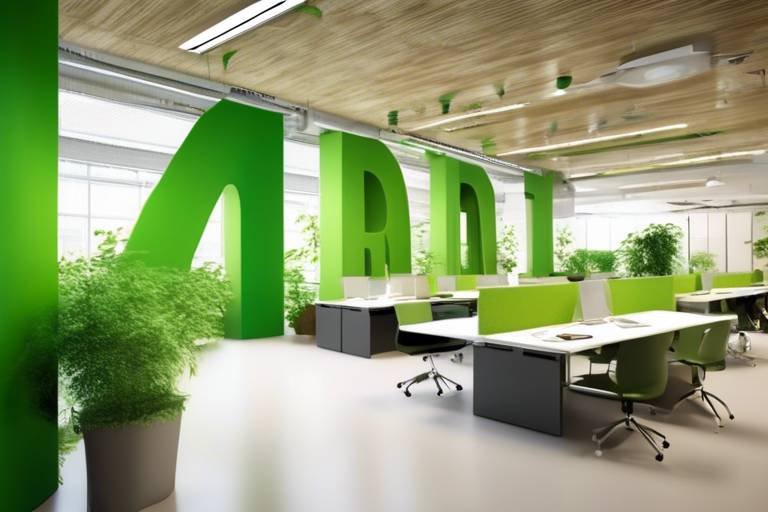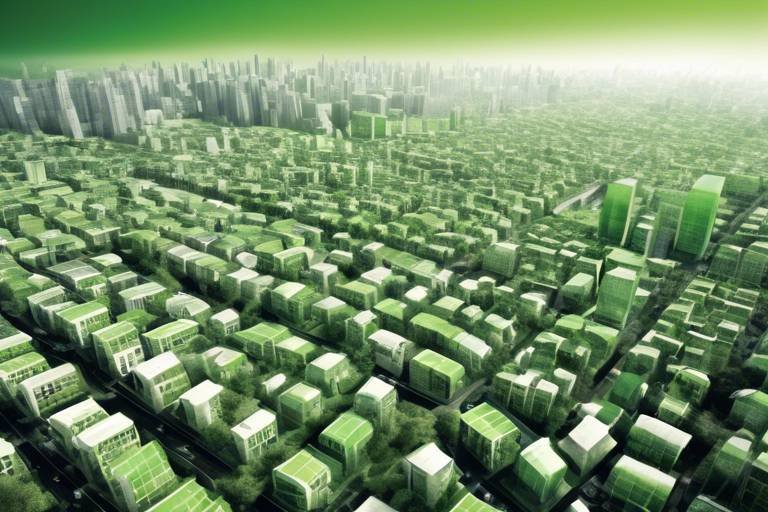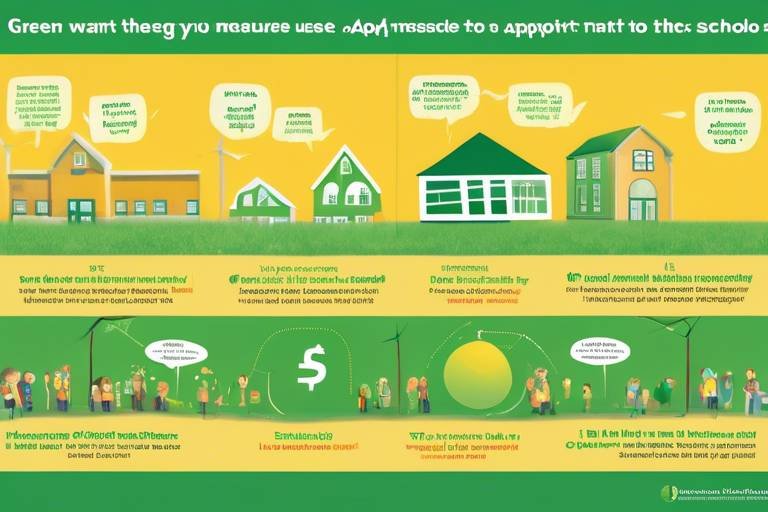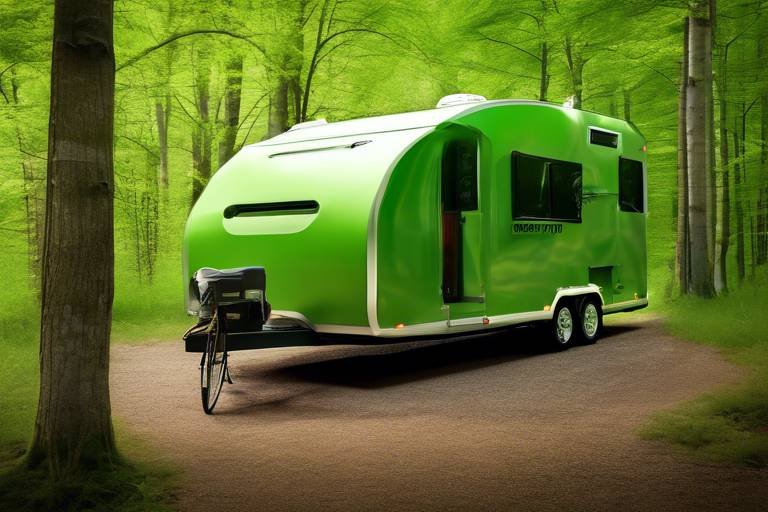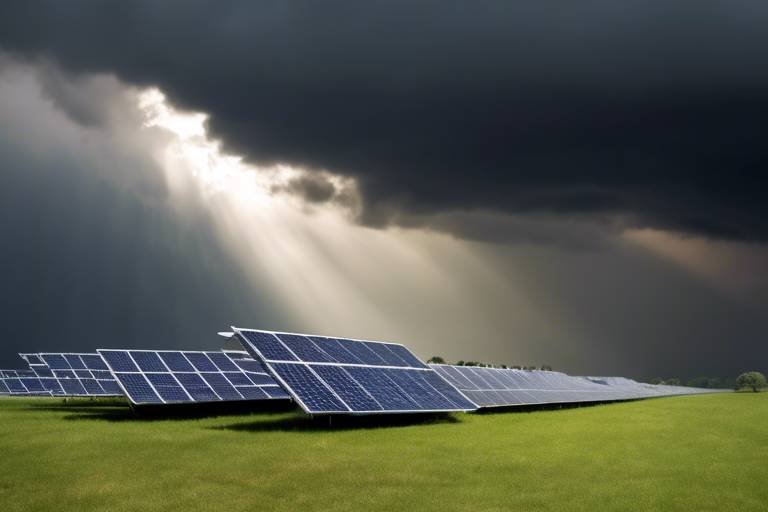Renters’ Guide to Green Energy – Is it Possible?
As the world becomes increasingly aware of the need for sustainable living, many renters find themselves asking, “Is it possible for me to adopt green energy solutions in my rental home?” The good news is that, yes, it is indeed feasible! While renters may face some unique challenges compared to homeowners, there are numerous practical steps they can take to embrace green energy and contribute to a healthier planet.
First off, let’s clarify what we mean by green energy. This term encompasses renewable energy sources that have a minimal impact on the environment, such as solar, wind, and hydroelectric power. For renters, understanding these options is crucial, as it opens up a world of possibilities for reducing their carbon footprint. Imagine living in a space that not only feels good but also does good for the environment—sounds appealing, right?
Now, you might be wondering why you should even consider going green if you’re just renting. Well, the benefits are compelling. Not only can adopting green energy practices lead to significant cost savings, but it can also improve your indoor air quality and overall health. Picture this: lower utility bills, a fresher living environment, and the satisfaction of knowing you’re doing your part for the planet. It’s a win-win situation!
However, the path to green energy isn’t without its hurdles. Many rental agreements come with restrictions that can make it challenging to implement changes. You might find yourself thinking, “How can I make a difference when my lease doesn’t allow modifications?” Fear not! There are still plenty of ways to incorporate sustainable practices without needing to overhaul your entire living space.
In this guide, we’ll delve deeper into the various aspects of green energy for renters, exploring the benefits, challenges, and practical tips to help you make eco-friendly choices. So, whether you’re a seasoned sustainability advocate or just starting your green journey, there’s something here for everyone. Let’s take this exciting step toward a more sustainable future together!
- Can renters install solar panels? Generally, renters cannot install solar panels on their rental properties. However, they can look into community solar programs that allow them to benefit from solar energy without needing to own property.
- What are some easy ways to save energy in a rental? Simple habits like turning off lights when not in use, unplugging devices, and using energy-efficient bulbs can lead to significant energy savings.
- How can I convince my landlord to adopt green energy practices? Start by having an open dialogue with your landlord. Present the benefits of green energy, such as increased property value and lower utility costs, to encourage them to consider sustainable upgrades.

Understanding Green Energy
When we talk about green energy, we're diving into a world of renewable resources that promise to reduce our environmental footprint while providing sustainable energy solutions. But what exactly qualifies as green energy? At its core, green energy comes from natural sources that are replenished faster than they are consumed. This includes the sun, wind, water, and even geothermal heat. Unlike fossil fuels, which release harmful pollutants and contribute to climate change, green energy sources offer a cleaner, healthier alternative.
One of the most significant aspects of green energy is its potential to combat global warming. By harnessing these renewable resources, we can significantly reduce the levels of carbon emissions that are currently choking our atmosphere. In fact, according to the Environmental Protection Agency, transitioning to renewable energy could cut greenhouse gas emissions by over 80% by 2050. This is particularly important for renters who may feel that their individual choices don’t make a difference. However, every small step counts, and understanding green energy is the first step towards making an impact.
Here’s a quick overview of the main types of green energy sources:
- Solar Energy: Captured from sunlight using solar panels, this energy source is becoming increasingly popular due to its accessibility and declining costs.
- Wind Energy: Generated by wind turbines, this form of energy harnesses the natural wind flow to produce electricity.
- Hydropower: Utilizing the flow of water, usually from rivers or dams, hydropower is one of the oldest and most established forms of renewable energy.
- Geothermal Energy: Tapping into the Earth’s internal heat, geothermal energy can be used for heating and electricity generation.
For renters, understanding these energy sources is crucial. Not only does it empower them to make informed decisions about their energy consumption, but it also opens up possibilities for integrating these practices into their rental agreements. Imagine living in a space where your energy comes from the sun, or where the breeze from outside powers your appliances. Sounds appealing, right?
Moreover, many rental properties are now beginning to adopt energy-efficient practices and green technologies, making it easier for renters to access these benefits. From energy-efficient appliances to community solar programs, the landscape is changing. Renters can advocate for energy-efficient upgrades in their homes and encourage their landlords to consider these options, ultimately leading to a win-win situation. By embracing green energy, renters can not only save money but also contribute to a healthier planet.

Benefits of Green Energy for Renters
When it comes to renting a home, many people might think that they are at the mercy of their landlords when it comes to energy choices. However, embracing green energy can be a game-changer for renters, offering a plethora of benefits that go beyond just saving a few bucks on utility bills. Imagine living in a space that not only feels good but also does good for the planet. Sounds appealing, right? Let’s dive into the various advantages that come with adopting sustainable energy practices in rental properties.
One of the most immediate benefits of switching to green energy is the potential for cost savings. Renters often face tight budgets, and any opportunity to lower monthly expenses is a welcome relief. By integrating energy-efficient solutions, such as LED lighting or Energy Star-rated appliances, renters can significantly reduce their electricity consumption. Over time, these savings can add up, allowing renters to allocate funds to other important areas of their lives, like travel or hobbies. In fact, studies show that households using energy-efficient appliances can save anywhere from 10% to 30% on their energy bills each month.
In addition to financial benefits, green energy can also lead to a healthier living environment. Many green energy solutions, like improved insulation and energy-efficient heating systems, contribute to better indoor air quality. This is crucial for renters, especially those with allergies or respiratory issues. By minimizing pollutants and ensuring better ventilation, renters can enjoy a more comfortable and healthier home. A recent study found that homes with energy-efficient systems reported a 25% decrease in indoor air pollutants, leading to fewer health complaints among residents.
Moreover, adopting green energy practices can have a positive impact on the environment. Renters who choose renewable energy sources, such as wind or solar, contribute to a reduction in their carbon footprint. This not only helps combat climate change but also sets a positive example for others in the community. When renters advocate for sustainable practices, they can inspire landlords and neighbors to follow suit, creating a ripple effect that promotes a more eco-conscious lifestyle.
To summarize, the benefits of green energy for renters can be categorized into three main areas:
- Cost Savings: Lower utility bills through energy-efficient appliances.
- Health Improvements: Enhanced indoor air quality leading to better well-being.
- Environmental Impact: Reduction of carbon footprints and promotion of sustainability.
In conclusion, renters should recognize that they have the power to make choices that benefit not only their wallets but also their health and the planet. By embracing green energy solutions, they can transform their living spaces into eco-friendly havens that reflect their values and contribute to a sustainable future.

Cost Savings
When it comes to living in a rental property, many people often overlook the potential for that come with adopting green energy practices. You might be wondering, "How can going green save me money?" Well, let’s break it down. One of the most significant ways renters can save money is through reduced utility bills. By making eco-friendly choices, such as using energy-efficient appliances or participating in community solar programs, you can see a noticeable difference in your monthly expenses.
For instance, consider the impact of switching to Energy Star-rated appliances. These appliances are designed to use less energy while providing the same level of performance as their conventional counterparts. The initial investment might seem daunting, but the long-term savings are undeniably worth it. According to the U.S. Department of Energy, replacing old appliances with energy-efficient ones can save you anywhere from $50 to $300 annually on your energy bills. Imagine what you could do with that extra cash!
Additionally, let’s talk about solar energy. While it’s true that renters typically can’t install solar panels on their roofs, community solar programs are a game-changer. These programs allow renters to buy or lease a portion of a solar array located off-site, meaning you can enjoy the benefits of solar energy without the need for physical installation. This can lead to savings of up to 10-20% on your electricity bill, depending on the program. It’s like having your cake and eating it too—enjoying renewable energy while saving money!
Now, if you're still skeptical about the savings, let’s look at a quick comparison table that illustrates the potential savings from various green energy initiatives:
| Green Energy Initiative | Potential Annual Savings |
|---|---|
| Energy-Efficient Appliances | $50 - $300 |
| Community Solar Programs | 10% - 20% on electricity bill |
| Smart Thermostats | $180 - $200 |
In addition to these savings, renters can also benefit from reduced maintenance costs. Energy-efficient appliances are often more reliable and require less frequent repairs, which can save you money in the long run. Plus, many utility companies offer incentives and rebates for renters who choose energy-efficient products, further enhancing your savings potential.
In conclusion, adopting green energy solutions isn’t just about being environmentally conscious; it’s also a smart financial decision. By investing in energy-efficient appliances and exploring community solar options, you can significantly lower your utility bills and enjoy a more affordable living experience. So why not take that leap into sustainability? Your wallet—and the planet—will thank you!
- Can renters install solar panels? Generally, renters cannot install solar panels on their rental properties, but they can participate in community solar programs.
- What are Energy Star-rated appliances? Energy Star-rated appliances are certified to be energy efficient, helping you save money on utility bills.
- How can I convince my landlord to support green energy initiatives? Open communication and presenting the financial benefits of green energy can encourage landlords to consider sustainable practices.

Energy-Efficient Appliances
When it comes to making a difference in your energy consumption as a renter, investing in energy-efficient appliances is one of the most impactful steps you can take. These appliances are designed to use less energy while delivering the same performance as their conventional counterparts. Imagine your refrigerator using 30% less energy than an older model; that’s like having a secret weapon against high utility bills!
Energy-efficient appliances are not just about saving money; they also contribute to a healthier environment. By reducing energy consumption, you’re helping to decrease greenhouse gas emissions. This means that every time you switch on your Energy Star-rated washing machine or dishwasher, you’re not only cleaning your clothes or dishes but also playing a part in the fight against climate change.
So, what should you look for when choosing energy-efficient appliances? Here are a few key features:
- Energy Star Certification: Look for the Energy Star label, which indicates that the appliance meets energy efficiency guidelines set by the U.S. Environmental Protection Agency.
- Smart Technology: Many new appliances come with smart technology that allows you to monitor and control energy usage remotely, making it easier to conserve energy.
- Size and Capacity: Choose appliances that fit your needs without being overly large. A smaller, efficient appliance can save more energy than a larger one that you don’t fully utilize.
While the initial investment in energy-efficient appliances may be higher than traditional models, the long-term savings on your utility bills can be substantial. For example, let’s take a look at a comparison of the average annual energy costs for different types of appliances:
| Appliance Type | Traditional Model Annual Cost | Energy-Efficient Model Annual Cost |
|---|---|---|
| Refrigerator | $150 | $100 |
| Washing Machine | $120 | $70 |
| Dishwasher | $120 | $80 |
As seen in the table, switching to energy-efficient appliances can lead to significant savings over time. It’s like finding money in your pocket every month! Plus, many utility companies offer rebates or incentives for upgrading to energy-efficient models, which can help offset the initial costs. So, not only are you making a smart financial decision, but you’re also contributing to a sustainable future.
In conclusion, as a renter, you may feel limited in your ability to make substantial changes to your living space, but investing in energy-efficient appliances is a powerful way to take control of your energy consumption. By making informed choices, you can enjoy a more comfortable home while also supporting a greener planet.

Solar Energy Options
For renters, the idea of harnessing the power of the sun might seem out of reach, especially when it comes to installing solar panels on a property they don’t own. However, the good news is that there are several innovative ways to tap into solar energy without the need for permanent installations. One of the most popular options is participating in community solar programs. These programs allow renters to buy or lease a portion of a solar farm, enabling them to benefit from solar energy without needing to install anything on their rental property.
Community solar programs work by pooling the resources of multiple participants to fund a larger solar installation, typically located off-site. This means that even if you live in an apartment or a rental home with limited roof access, you can still enjoy the perks of solar energy. When you enroll in a community solar program, you usually receive credits on your utility bill that correspond to the amount of energy produced by your share of the solar farm. This can lead to significant savings, especially during peak usage times when electricity costs are higher.
Another option for renters is to utilize solar energy purchasing agreements (SEPAs). These agreements allow renters to purchase solar energy directly from a provider at a fixed rate, which can be lower than the local utility rates. This type of arrangement is particularly beneficial for those who want to support renewable energy initiatives and contribute to a greener planet while saving money.
It's also worth noting that some innovative companies are now offering portable solar panels that can be easily set up and taken down. These panels are perfect for renters who want to harness solar energy without making permanent changes to their living space. While these setups might not provide enough power for an entire home, they can be perfect for charging devices, powering small appliances, or even lighting up outdoor spaces.
In summary, while the traditional route of installing solar panels may not be feasible for renters, there are still plenty of exciting alternatives available. By exploring community solar programs, solar energy purchasing agreements, or even portable solar solutions, renters can enjoy the benefits of solar energy, reduce their electricity costs, and contribute to a sustainable future. Embracing these options not only enhances personal savings but also fosters a sense of community and collective responsibility towards the environment.
- Can renters install solar panels on their property? Generally, renters cannot install solar panels without landlord permission. However, community solar programs and other alternatives exist.
- What are community solar programs? Community solar programs allow multiple participants to share the benefits of a single solar installation, making solar energy accessible to those who cannot install panels on their own property.
- How can I find a community solar program near me? You can check with your local utility company or search online for community solar initiatives in your area.
- Are portable solar panels worth it? Portable solar panels can be a great investment for renters looking to reduce energy costs for small devices, though they may not power an entire home.

Improving Indoor Air Quality
When it comes to our homes, the air we breathe is often overlooked, yet it plays a crucial role in our overall health and well-being. is not just a luxury; it's a necessity, especially for renters who may not have control over the structural aspects of their living spaces. By adopting green energy solutions and sustainable practices, renters can significantly enhance the air quality in their homes. Imagine your living space as a sanctuary, where the air is fresh, clean, and invigorating—this can be achieved through some thoughtful choices.
One of the most effective ways to improve indoor air quality is by utilizing energy-efficient appliances. These appliances not only consume less energy but also produce fewer pollutants. For example, using an Energy Star-rated refrigerator or air conditioner can reduce the amount of harmful emissions released into your home. Moreover, these appliances often come with better filtration systems that help trap dust, allergens, and other airborne particles, ensuring that the air you breathe is as clean as possible.
Another vital aspect of maintaining good indoor air quality is proper ventilation. Many rental properties may not have the best airflow, which can lead to stale air and a buildup of indoor pollutants. Renters can improve ventilation by:
- Opening windows regularly to allow fresh air to circulate.
- Using exhaust fans in kitchens and bathrooms to remove moisture and odors.
- Investing in air purifiers that use HEPA filters to trap harmful particles.
Additionally, incorporating indoor plants can be a game-changer. Not only do they add a touch of nature to your space, but many plants also act as natural air purifiers. For instance, plants like spider plants, snake plants, and peace lilies are known for their ability to absorb toxins and release oxygen, creating a healthier indoor environment. Just think of them as your green allies in the quest for cleaner air!
It's also essential to be mindful of the materials used in your home. Many common household items, from paint to furniture, can emit volatile organic compounds (VOCs) that degrade indoor air quality. When possible, opt for low-VOC paints, eco-friendly furniture, and natural cleaning products. This simple switch can make a significant difference in the air quality of your rental space.
Lastly, don't forget about the importance of regular maintenance. Changing air filters in heating and cooling systems, cleaning vents, and ensuring that there are no leaks or mold issues can drastically improve the air quality in your home. As a renter, you might not have the authority to make major changes, but you can certainly advocate for these practices with your landlord.
In conclusion, improving indoor air quality is not just about making your home feel fresher; it's about creating a healthier living environment. By implementing these green energy solutions and sustainable practices, renters can breathe easier and enjoy the myriad benefits that come with cleaner air. So why not take a step towards a healthier home today?
Q: Can I improve indoor air quality without making significant changes to my rental property?
A: Absolutely! Simple actions like using air purifiers, keeping windows open, and choosing low-VOC products can significantly enhance your indoor air quality.
Q: What types of plants are best for improving indoor air quality?
A: Some of the best plants for air purification include spider plants, snake plants, and peace lilies. These plants are not only beautiful but also effective at filtering toxins from the air.
Q: How often should I change air filters in my home?
A: It's generally recommended to change air filters every 1-3 months, depending on usage and the type of filter. Regular maintenance can greatly improve air quality.

Challenges for Renters
While the idea of embracing green energy is certainly appealing, renters often find themselves facing a unique set of challenges that can make the transition to sustainable living a bit tricky. One of the most significant hurdles is the lease agreements that many renters must adhere to. These agreements often contain clauses that restrict modifications to the rental property, which can include anything from installing energy-efficient appliances to making structural changes for solar panel installations. So, how can renters navigate these restrictions while still pursuing eco-friendly solutions? It's all about communication and creativity!
Another major obstacle is the landlord cooperation factor. In many cases, the success of implementing green energy solutions hinges on the willingness of landlords to support such initiatives. Unfortunately, not all landlords are on board with the idea of investing in sustainable practices, especially if it means upfront costs or changes to their property. For renters, this can feel like hitting a brick wall. However, there are strategies that can be employed to encourage landlords to embrace greener options, such as presenting them with the potential for increased property value and attracting environmentally conscious tenants.
Additionally, renters may encounter financial challenges when trying to adopt green energy practices. Many eco-friendly products, like energy-efficient appliances or smart home devices, come with a higher upfront cost. This can be a tough sell for renters who are already juggling monthly bills and living expenses. However, the long-term savings on utility bills can often outweigh these initial costs. It's essential for renters to conduct thorough research and possibly even seek out incentives or rebates available in their area to offset these expenses.
To summarize, the challenges renters face in adopting green energy solutions include:
- Restrictions in lease agreements
- Lack of landlord cooperation
- Financial barriers related to upfront costs
Despite these challenges, it's important for renters to remember that every small step towards sustainability counts. Even if major modifications aren't feasible, there are still plenty of ways to incorporate green practices into daily life. With a little creativity, persistence, and perhaps a friendly chat with the landlord, renters can pave the way for a greener lifestyle.
Q: Can I install solar panels in my rental property?
A: Generally, renters cannot install solar panels without landlord permission. However, you can explore community solar programs that allow you to benefit from solar energy without needing to own property.
Q: What if my lease prohibits modifications?
A: If your lease has restrictions, consider discussing it with your landlord. You might find that they are open to small changes that can enhance energy efficiency, such as using energy-efficient light bulbs or appliances.
Q: Are there financial incentives for renters to go green?
A: Yes! Many local governments and utilities offer rebates and incentives for energy-efficient upgrades. Research what’s available in your area to help offset costs.
Q: How can I improve my indoor air quality as a renter?
A: Simple actions like using air purifiers, keeping windows open for ventilation, and using non-toxic cleaning products can significantly enhance indoor air quality.

Lease Agreements
When it comes to embracing green energy solutions as a renter, can often feel like a double-edged sword. On one hand, they provide a sense of security and clarity regarding what modifications you can make to your living space; on the other hand, they can be quite restrictive, particularly when it comes to making eco-friendly changes. Many leases explicitly state that tenants are not allowed to alter the property in any significant way, which can include the installation of energy-efficient appliances or even solar panels. So, how can you navigate these restrictions while still pursuing a sustainable lifestyle?
First, it's essential to carefully read your lease agreement. Look for clauses that mention modifications, improvements, or alterations. If you're unsure about any language, don't hesitate to ask your landlord for clarification. Remember, communication is key! If your lease does have restrictive clauses, consider approaching your landlord with a proposal. You might be surprised to find that they are open to discussions about energy-efficient upgrades, especially if you can demonstrate how these changes could potentially increase the property’s value or lower utility costs.
Here are some strategies you can employ:
- Propose a Trial Period: Suggest a temporary installation of energy-efficient appliances, offering to revert them back if your landlord is not satisfied with the results.
- Highlight Benefits: Emphasize the advantages of green energy solutions, not just for you, but for the property owner as well. Lower utility bills can be a strong selling point.
- Seek Permission: Always ask for permission before making any changes. A simple email or conversation can go a long way in establishing trust.
Additionally, consider looking for rental properties that are already equipped with green energy solutions. This not only saves you the hassle of negotiating with landlords but also allows you to enjoy the benefits of a sustainable living environment right from the start. Websites that specialize in eco-friendly rentals can be a good place to start your search.
Ultimately, while lease agreements can pose challenges, they don’t have to be a barrier to adopting green energy practices. By being proactive, communicating effectively, and seeking out properties that align with your sustainability goals, you can create a greener living space even as a renter.
Q1: Can I install solar panels if I am renting?
A1: Generally, renters cannot install solar panels without landlord permission. However, you can explore community solar programs that allow you to benefit from solar energy without needing to install panels on your property.
Q2: What should I do if my lease prohibits modifications?
A2: If your lease restricts modifications, discuss your interest in green energy solutions with your landlord. They may be open to negotiations or may allow certain changes if you present the benefits.
Q3: Are there energy-efficient appliances I can use without modifying my rental?
A3: Yes! You can use portable energy-efficient appliances, such as energy-saving light bulbs or smart power strips, which do not require any modifications to your rental.
Q4: How can I find eco-friendly rental properties?
A4: Look for websites that specialize in eco-friendly rentals, or check local listings that highlight green features. You can also inquire with real estate agents about available sustainable housing options.

Landlord Cooperation
When it comes to adopting green energy solutions, one of the biggest hurdles renters face is the need for . Think of it like trying to bake a cake without the right ingredients; no matter how much you want it, you simply can’t do it alone. Renters often find themselves in a tug-of-war with their landlords, who may be hesitant to embrace sustainable practices due to concerns about costs, property modifications, or even the perceived value of green upgrades. However, fostering a positive relationship with your landlord can open the door to numerous possibilities.
First, communication is key. Renters should approach their landlords with well-researched proposals that outline the benefits of green energy solutions. For instance, if you suggest installing energy-efficient appliances or participating in a community solar program, you can highlight how these changes can lead to lower utility bills, which is a win-win for both parties. It’s essential to frame these discussions in a way that emphasizes cost savings and potential increases in property value, as these are often the primary concerns for landlords.
Moreover, consider the following strategies to encourage your landlord's cooperation:
- Present Data: Share statistics about energy savings and increased tenant satisfaction in properties with green upgrades.
- Offer to Share Costs: If possible, propose a cost-sharing arrangement for installing energy-efficient systems.
- Highlight Tax Incentives: Inform your landlord about any available tax credits or incentives for green upgrades that could alleviate financial concerns.
Additionally, it's beneficial to build a rapport with your landlord. Regularly check in and express appreciation for their efforts in maintaining the property. This can create a more collaborative atmosphere where your landlord is more likely to consider your suggestions. If your landlord is still resistant, you might explore the option of gathering support from other tenants. A united front can often persuade landlords to take action, especially if they see that multiple tenants are interested in sustainable practices.
In summary, while the road to green energy adoption as a renter can be rocky, establishing a cooperative relationship with your landlord can pave the way for sustainable living. By communicating effectively, presenting compelling arguments, and building a rapport, you can increase your chances of getting your landlord on board with green energy solutions.
Q1: What should I do if my landlord refuses to consider green energy options?
A1: If your landlord is not open to suggestions, consider discussing the benefits of green energy with other tenants to create a collective request. You can also explore alternative options, such as community solar programs, that do not require landlord approval.
Q2: How can I convince my landlord that green upgrades are worth the investment?
A2: Present data on energy savings and improved property values that come with green upgrades. Highlight any available tax incentives or rebates that can offset the initial costs.
Q3: Can I install energy-efficient appliances without my landlord's permission?
A3: Typically, any significant modifications to a rental property require landlord approval. However, you can discuss the possibility of using portable energy-efficient appliances that do not require permanent installation.
Q4: What if my lease agreement restricts modifications for green energy solutions?
A4: Review your lease agreement carefully and discuss any restrictions with your landlord. You may find opportunities to negotiate or suggest temporary solutions that comply with the lease.

Practical Tips for Renters
As a renter, embracing green energy practices might seem daunting, but it’s more achievable than you think! With a few practical tips, you can make a significant impact on your energy consumption and contribute to a healthier planet. First and foremost, become aware of your energy usage. This means monitoring how much energy your household consumes on a monthly basis. Many utility companies provide online tools to help you track your usage, making it easier to identify areas where you can cut back.
Another effective strategy is to adopt energy-saving habits in your daily routine. For example, consider setting your thermostat a few degrees lower in the winter and higher in the summer. This simple adjustment can lead to substantial savings over time. Additionally, remember to unplug electronics when they’re not in use; devices like chargers and entertainment systems can still draw power even when turned off. You might be surprised to learn that this phenomenon, known as "phantom load," can account for a significant portion of your electricity bill!
When it comes to lighting, opt for LED bulbs instead of traditional incandescent ones. While they may cost a bit more upfront, LED bulbs last much longer and use far less energy, making them a smart investment. Plus, they come in various styles and colors to suit your aesthetic preferences. If you’re feeling crafty, you can even create your own natural light sources by rearranging furniture to maximize sunlight during the day.
For those looking to make a bigger impact, consider exploring community solar programs. These initiatives allow renters to participate in solar energy projects without the need to install panels on their own homes. By opting into these programs, you can support renewable energy while often receiving credits on your utility bill. It's a win-win situation that not only benefits you financially but also contributes to the growth of sustainable energy sources.
Lastly, don't underestimate the power of eco-friendly products. When shopping for cleaning supplies, look for brands that prioritize sustainability. Many companies now offer biodegradable or plant-based options that are just as effective as traditional products but much gentler on the environment. You can also search for local stores that specialize in zero-waste products, allowing you to reduce plastic usage significantly.
In summary, while renters may face certain limitations, there are numerous practical tips and strategies to incorporate green energy into your lifestyle. By adopting energy-saving habits, investing in eco-friendly products, and exploring community solar options, you can contribute to a more sustainable future without sacrificing comfort or convenience.
- Can renters install solar panels on their property?
No, typically renters cannot install solar panels on rental properties. However, community solar programs are a great alternative. - What should I do if my landlord is not supportive of green energy practices?
Communicate with your landlord about the benefits of green energy and propose small changes that require minimal investment. - Are energy-efficient appliances worth the investment?
Yes, while they may cost more initially, energy-efficient appliances can lead to significant savings on your utility bills over time.

Energy-Saving Habits
When it comes to saving energy in a rental property, small changes can lead to big savings. Have you ever thought about how your daily habits impact your energy consumption? It’s like the ripple effect; one small action can create waves of positive change. Here are some practical habits that can help you cut down on your energy use and lower those pesky utility bills.
First off, let's talk about lighting. Switching out traditional incandescent bulbs for LED lights is a game changer. Not only do LEDs use up to 75% less energy, but they also last significantly longer. Imagine the money you could save by simply changing your light bulbs! And don’t forget to turn off the lights when you leave a room. It sounds simple, but this habit can save you more than you think.
Next up is your heating and cooling. Many renters don't have control over the thermostat settings, but that doesn't mean you can't take steps to manage your comfort and energy use. For instance, using draft stoppers or weather stripping can help keep your home warm in the winter and cool in the summer. You can also invest in a programmable thermostat if your landlord allows it. This way, you can set temperatures to adjust automatically when you're away, reducing unnecessary energy use.
Another effective habit is being mindful of your appliance usage. For example, try to run your dishwasher and washing machine only when they're full. This not only saves energy but also conserves water. And when you do use these appliances, consider using the eco mode if available. It’s designed to use less energy and water, making it a win-win for both your wallet and the environment.
Did you know that unplugging devices when they're not in use can also lead to significant energy savings? Many electronics draw power even when turned off, a phenomenon known as phantom load. To combat this, you might consider using a power strip that you can easily turn off when devices are not in use. It’s an effortless habit that can add up over time.
Lastly, let’s not forget about smart energy practices. If your rental allows, consider investing in smart home devices, such as smart plugs or smart bulbs. These devices can be controlled remotely and programmed to turn off when not needed. It's like having a personal energy assistant right in your pocket!
By adopting these energy-saving habits, renters can make a noticeable difference in their energy consumption. Not only do these practices help in reducing bills, but they also contribute to a more sustainable lifestyle. So, why not start today? Every small step counts toward a greener future!
- Can renters install energy-efficient appliances?
Generally, renters may not have the authority to install permanent appliances. However, they can choose to use portable energy-efficient appliances, like mini dishwashers or energy-efficient heaters, if allowed by the lease. - What are some quick ways to save energy in a rental?
Simple actions like turning off lights, unplugging devices, and using natural light can significantly reduce energy consumption. - Are there any grants or programs for renters to go green?
Yes! Many local governments and organizations offer incentives for renters to adopt green practices. It's worth researching what's available in your area.

Finding Eco-Friendly Products
Finding eco-friendly products while renting can feel like searching for a needle in a haystack, but it doesn't have to be overwhelming. The good news is that many retailers are now prioritizing sustainability, making it easier for renters to make environmentally conscious choices. When you're on the hunt for these products, consider looking for items that are labeled as recyclable, biodegradable, or made from renewable resources. These labels can often serve as a quick guide to identifying products that align with your green values.
Start by exploring local stores that specialize in sustainable goods. Many cities have shops dedicated to eco-friendly products, ranging from cleaning supplies to personal care items. Additionally, online platforms have emerged that focus solely on sustainable living, allowing you to browse a wide array of options from the comfort of your home. Websites like EarthHero and Package Free Shop offer everything from reusable bags to biodegradable kitchenware, all in one place.
Another great way to find eco-friendly products is to look for those that carry certifications such as Energy Star for appliances or Green Seal for cleaning products. These certifications indicate that the products meet specific environmental standards, ensuring that you're making a responsible choice. For instance, when selecting cleaning supplies, opt for brands that use natural ingredients and avoid harsh chemicals, which can be harmful to both your health and the environment.
Moreover, consider the lifecycle of the products you purchase. Ask yourself questions like: How long will this product last? and Can it be recycled or composted after use? This mindset not only helps you choose better products but also encourages a more sustainable lifestyle overall. For example, when it comes to personal care items, look for options that come in recyclable packaging or are refillable, reducing waste significantly.
Lastly, don't hesitate to reach out to your landlord or property manager about eco-friendly upgrades. While you may not be able to make significant changes to the property, they might be open to installing energy-efficient lighting or providing recycling bins if they see that tenants are interested in sustainable practices. Engaging in a conversation about sustainability can lead to positive changes that benefit everyone in the building.
In summary, finding eco-friendly products is all about being resourceful and informed. By seeking out retailers that prioritize sustainability, looking for certifications, and being mindful of the products' lifecycle, you can make choices that not only benefit your living space but also contribute to a healthier planet.
- What are some examples of eco-friendly products? Eco-friendly products include biodegradable cleaning supplies, energy-efficient appliances, reusable bags, and sustainably sourced furniture.
- How can I ensure the products I buy are truly eco-friendly? Look for certifications such as Energy Star, Green Seal, or USDA Organic, and research the brands to understand their sustainability practices.
- Are eco-friendly products more expensive? While some eco-friendly products may have a higher upfront cost, they often save money in the long run through durability and energy savings.
- Can I make my own eco-friendly products? Yes! Many household items like cleaning supplies can be made with simple ingredients like vinegar, baking soda, and essential oils.
Frequently Asked Questions
- Can renters install solar panels on their rental properties?
Generally, renters cannot install solar panels without the landlord's permission. However, many areas offer community solar programs where renters can buy into solar energy without needing to install panels on their homes. This way, you can still benefit from renewable energy!
- What are some easy ways renters can save energy?
There are several simple habits that can help renters save energy, such as:
- Unplugging devices when not in use
- Using LED light bulbs
- Setting thermostats wisely
- Utilizing natural light during the day
These small changes can lead to significant savings on your utility bills!
- Are energy-efficient appliances worth the investment for renters?
Absolutely! Investing in Energy Star-rated appliances can help reduce energy consumption and lower your bills. Even if you’re renting, using these appliances can improve your living environment and potentially save you money in the long run.
- What challenges do renters face when trying to go green?
Renters often face challenges like restrictive lease agreements that limit modifications to the property and the need for landlord cooperation to implement green solutions. It’s essential for renters to communicate with their landlords and explore eco-friendly options that comply with their lease.
- How can renters encourage their landlords to adopt green practices?
Open communication is key! Renters can present the benefits of green practices, such as potential cost savings and improved property value. Suggesting small changes, like installing energy-efficient lighting or promoting recycling programs, can also be a great starting point.
- Where can renters find eco-friendly products?
Renters can find eco-friendly products at local stores, online retailers, or through community resources. Look for labels that indicate sustainability, and consider checking out websites dedicated to green living for recommendations.


